Leading and Managing Change: A Comparative Analysis Report
VerifiedAdded on 2020/05/16
|10
|2791
|106
Report
AI Summary
This report provides a detailed analysis of change management models, focusing on Lewin's three-stage model, McKinsey's 7S model, and Kotter's eight-step theory. It explores the core concepts, advantages, and disadvantages of each model, offering practical examples of their application in organizational settings. The report highlights the importance of understanding and adapting to change within organizations, emphasizing the role of leaders and managers in facilitating transitions. It also discusses the learning styles and resources available for individuals to further their understanding of change management, including evidence-based sources, workshops, and interviews with industry experts. The report concludes by synthesizing the key insights from the models, offering a comprehensive guide for developing effective change management strategies.
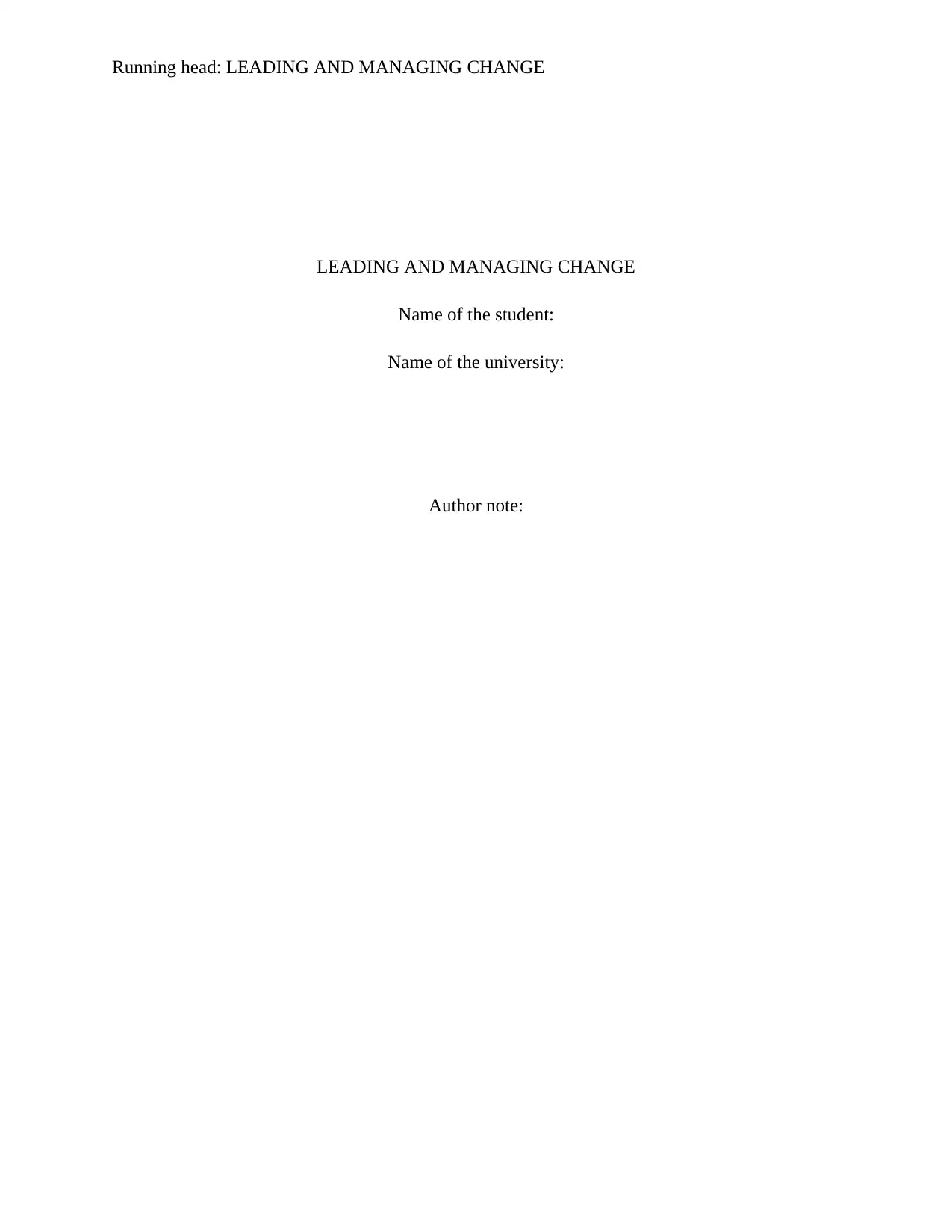
Running head: LEADING AND MANAGING CHANGE
LEADING AND MANAGING CHANGE
Name of the student:
Name of the university:
Author note:
LEADING AND MANAGING CHANGE
Name of the student:
Name of the university:
Author note:
Paraphrase This Document
Need a fresh take? Get an instant paraphrase of this document with our AI Paraphraser
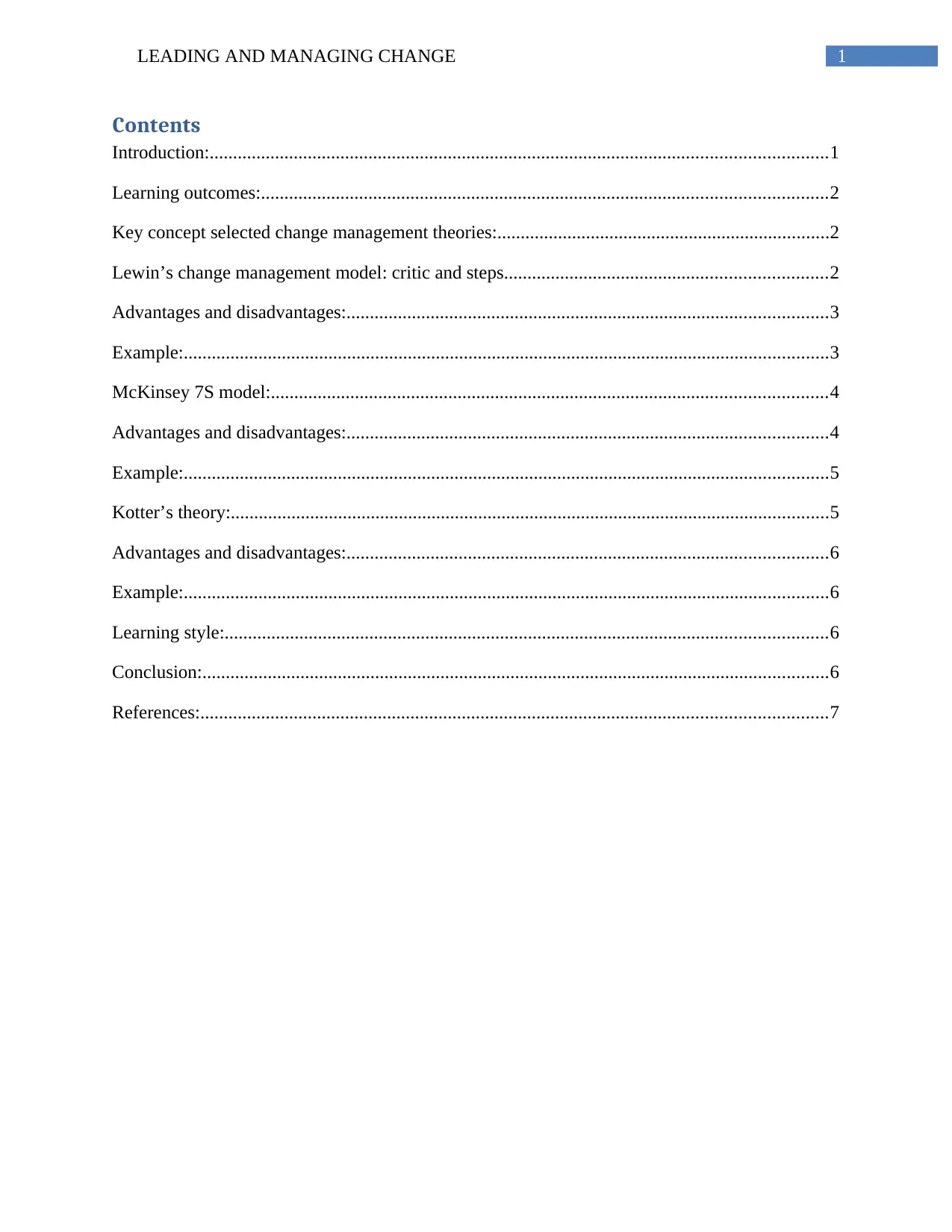
1LEADING AND MANAGING CHANGE
Contents
Introduction:....................................................................................................................................1
Learning outcomes:.........................................................................................................................2
Key concept selected change management theories:.......................................................................2
Lewin’s change management model: critic and steps.....................................................................2
Advantages and disadvantages:.......................................................................................................3
Example:..........................................................................................................................................3
McKinsey 7S model:.......................................................................................................................4
Advantages and disadvantages:.......................................................................................................4
Example:..........................................................................................................................................5
Kotter’s theory:................................................................................................................................5
Advantages and disadvantages:.......................................................................................................6
Example:..........................................................................................................................................6
Learning style:.................................................................................................................................6
Conclusion:......................................................................................................................................6
References:......................................................................................................................................7
Contents
Introduction:....................................................................................................................................1
Learning outcomes:.........................................................................................................................2
Key concept selected change management theories:.......................................................................2
Lewin’s change management model: critic and steps.....................................................................2
Advantages and disadvantages:.......................................................................................................3
Example:..........................................................................................................................................3
McKinsey 7S model:.......................................................................................................................4
Advantages and disadvantages:.......................................................................................................4
Example:..........................................................................................................................................5
Kotter’s theory:................................................................................................................................5
Advantages and disadvantages:.......................................................................................................6
Example:..........................................................................................................................................6
Learning style:.................................................................................................................................6
Conclusion:......................................................................................................................................6
References:......................................................................................................................................7

2LEADING AND MANAGING CHANGE
Individual assignment:
Introduction:
Change management can be defined as the procedure that helps in easing out the
organizational transitions. Effective leading and managing of changes in organization can help
the employees in understanding, committing to, accepting and embracing changes in their proper
business environment. Changes can take place in organizations in different ways that may
include strategic, technological as well as leadership changes (Hornstein, 2015). Present day
examples show that change management are playing important role in implementation of new
technologies. A large number of people fear that with the development of technology, the trend
will take over many work places and pose a threat to existing employees. This often results in
causing resistance to changes in the forms who are implementing new technology in their
premises or among their working styles. By properly helping the employees to understand the
changes in better ways, leaders and managers can help in development of workplace that is not
only open-minded but are also open to change (Lewis, Passmore & Cantore, 2016). The
assignment will thereby show how models are helpful and portray their benefits and
disadvantages.
Learning outcomes:
Managers will learn the factors associated with changes from Mc.Kinsey model
Managers will learn how step by step process can be followed for effective changes
Managers will learn about which model to be applied in which situations.
Managers will be able to develop their own personal change management plan depending
on disadvantages and benefits of the models.
Key concept selected change management theories:
Lewin’s change management model: critic and steps
Lewin’s change management model is one of the most popular models that break up the
change procedure in three stages. These three stages are unfreezing, making change and
refreezing. When the manager realizes that the company needs to change, the first step he needs
Individual assignment:
Introduction:
Change management can be defined as the procedure that helps in easing out the
organizational transitions. Effective leading and managing of changes in organization can help
the employees in understanding, committing to, accepting and embracing changes in their proper
business environment. Changes can take place in organizations in different ways that may
include strategic, technological as well as leadership changes (Hornstein, 2015). Present day
examples show that change management are playing important role in implementation of new
technologies. A large number of people fear that with the development of technology, the trend
will take over many work places and pose a threat to existing employees. This often results in
causing resistance to changes in the forms who are implementing new technology in their
premises or among their working styles. By properly helping the employees to understand the
changes in better ways, leaders and managers can help in development of workplace that is not
only open-minded but are also open to change (Lewis, Passmore & Cantore, 2016). The
assignment will thereby show how models are helpful and portray their benefits and
disadvantages.
Learning outcomes:
Managers will learn the factors associated with changes from Mc.Kinsey model
Managers will learn how step by step process can be followed for effective changes
Managers will learn about which model to be applied in which situations.
Managers will be able to develop their own personal change management plan depending
on disadvantages and benefits of the models.
Key concept selected change management theories:
Lewin’s change management model: critic and steps
Lewin’s change management model is one of the most popular models that break up the
change procedure in three stages. These three stages are unfreezing, making change and
refreezing. When the manager realizes that the company needs to change, the first step he needs
⊘ This is a preview!⊘
Do you want full access?
Subscribe today to unlock all pages.

Trusted by 1+ million students worldwide
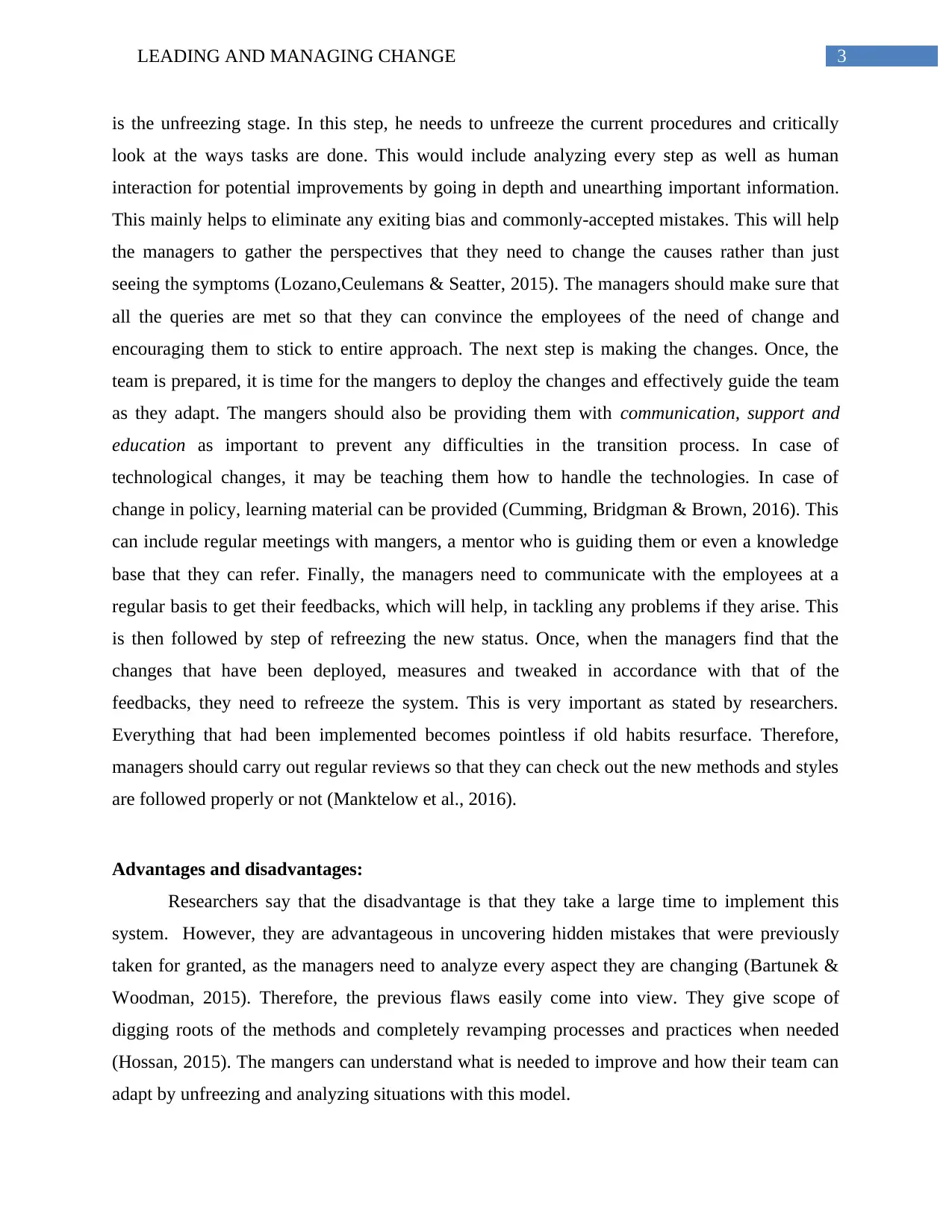
3LEADING AND MANAGING CHANGE
is the unfreezing stage. In this step, he needs to unfreeze the current procedures and critically
look at the ways tasks are done. This would include analyzing every step as well as human
interaction for potential improvements by going in depth and unearthing important information.
This mainly helps to eliminate any exiting bias and commonly-accepted mistakes. This will help
the managers to gather the perspectives that they need to change the causes rather than just
seeing the symptoms (Lozano,Ceulemans & Seatter, 2015). The managers should make sure that
all the queries are met so that they can convince the employees of the need of change and
encouraging them to stick to entire approach. The next step is making the changes. Once, the
team is prepared, it is time for the mangers to deploy the changes and effectively guide the team
as they adapt. The mangers should also be providing them with communication, support and
education as important to prevent any difficulties in the transition process. In case of
technological changes, it may be teaching them how to handle the technologies. In case of
change in policy, learning material can be provided (Cumming, Bridgman & Brown, 2016). This
can include regular meetings with mangers, a mentor who is guiding them or even a knowledge
base that they can refer. Finally, the managers need to communicate with the employees at a
regular basis to get their feedbacks, which will help, in tackling any problems if they arise. This
is then followed by step of refreezing the new status. Once, when the managers find that the
changes that have been deployed, measures and tweaked in accordance with that of the
feedbacks, they need to refreeze the system. This is very important as stated by researchers.
Everything that had been implemented becomes pointless if old habits resurface. Therefore,
managers should carry out regular reviews so that they can check out the new methods and styles
are followed properly or not (Manktelow et al., 2016).
Advantages and disadvantages:
Researchers say that the disadvantage is that they take a large time to implement this
system. However, they are advantageous in uncovering hidden mistakes that were previously
taken for granted, as the managers need to analyze every aspect they are changing (Bartunek &
Woodman, 2015). Therefore, the previous flaws easily come into view. They give scope of
digging roots of the methods and completely revamping processes and practices when needed
(Hossan, 2015). The mangers can understand what is needed to improve and how their team can
adapt by unfreezing and analyzing situations with this model.
is the unfreezing stage. In this step, he needs to unfreeze the current procedures and critically
look at the ways tasks are done. This would include analyzing every step as well as human
interaction for potential improvements by going in depth and unearthing important information.
This mainly helps to eliminate any exiting bias and commonly-accepted mistakes. This will help
the managers to gather the perspectives that they need to change the causes rather than just
seeing the symptoms (Lozano,Ceulemans & Seatter, 2015). The managers should make sure that
all the queries are met so that they can convince the employees of the need of change and
encouraging them to stick to entire approach. The next step is making the changes. Once, the
team is prepared, it is time for the mangers to deploy the changes and effectively guide the team
as they adapt. The mangers should also be providing them with communication, support and
education as important to prevent any difficulties in the transition process. In case of
technological changes, it may be teaching them how to handle the technologies. In case of
change in policy, learning material can be provided (Cumming, Bridgman & Brown, 2016). This
can include regular meetings with mangers, a mentor who is guiding them or even a knowledge
base that they can refer. Finally, the managers need to communicate with the employees at a
regular basis to get their feedbacks, which will help, in tackling any problems if they arise. This
is then followed by step of refreezing the new status. Once, when the managers find that the
changes that have been deployed, measures and tweaked in accordance with that of the
feedbacks, they need to refreeze the system. This is very important as stated by researchers.
Everything that had been implemented becomes pointless if old habits resurface. Therefore,
managers should carry out regular reviews so that they can check out the new methods and styles
are followed properly or not (Manktelow et al., 2016).
Advantages and disadvantages:
Researchers say that the disadvantage is that they take a large time to implement this
system. However, they are advantageous in uncovering hidden mistakes that were previously
taken for granted, as the managers need to analyze every aspect they are changing (Bartunek &
Woodman, 2015). Therefore, the previous flaws easily come into view. They give scope of
digging roots of the methods and completely revamping processes and practices when needed
(Hossan, 2015). The mangers can understand what is needed to improve and how their team can
adapt by unfreezing and analyzing situations with this model.
Paraphrase This Document
Need a fresh take? Get an instant paraphrase of this document with our AI Paraphraser
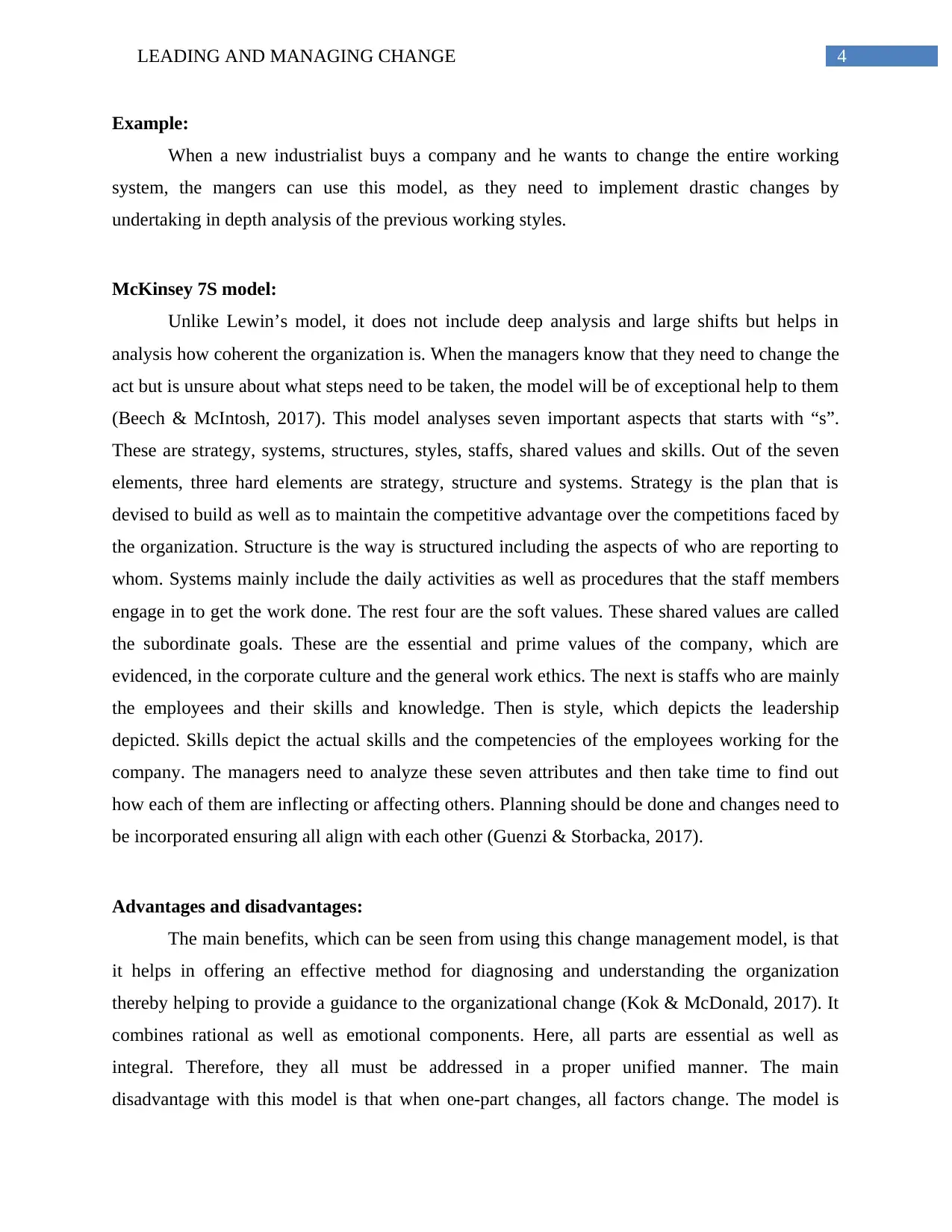
4LEADING AND MANAGING CHANGE
Example:
When a new industrialist buys a company and he wants to change the entire working
system, the mangers can use this model, as they need to implement drastic changes by
undertaking in depth analysis of the previous working styles.
McKinsey 7S model:
Unlike Lewin’s model, it does not include deep analysis and large shifts but helps in
analysis how coherent the organization is. When the managers know that they need to change the
act but is unsure about what steps need to be taken, the model will be of exceptional help to them
(Beech & McIntosh, 2017). This model analyses seven important aspects that starts with “s”.
These are strategy, systems, structures, styles, staffs, shared values and skills. Out of the seven
elements, three hard elements are strategy, structure and systems. Strategy is the plan that is
devised to build as well as to maintain the competitive advantage over the competitions faced by
the organization. Structure is the way is structured including the aspects of who are reporting to
whom. Systems mainly include the daily activities as well as procedures that the staff members
engage in to get the work done. The rest four are the soft values. These shared values are called
the subordinate goals. These are the essential and prime values of the company, which are
evidenced, in the corporate culture and the general work ethics. The next is staffs who are mainly
the employees and their skills and knowledge. Then is style, which depicts the leadership
depicted. Skills depict the actual skills and the competencies of the employees working for the
company. The managers need to analyze these seven attributes and then take time to find out
how each of them are inflecting or affecting others. Planning should be done and changes need to
be incorporated ensuring all align with each other (Guenzi & Storbacka, 2017).
Advantages and disadvantages:
The main benefits, which can be seen from using this change management model, is that
it helps in offering an effective method for diagnosing and understanding the organization
thereby helping to provide a guidance to the organizational change (Kok & McDonald, 2017). It
combines rational as well as emotional components. Here, all parts are essential as well as
integral. Therefore, they all must be addressed in a proper unified manner. The main
disadvantage with this model is that when one-part changes, all factors change. The model is
Example:
When a new industrialist buys a company and he wants to change the entire working
system, the mangers can use this model, as they need to implement drastic changes by
undertaking in depth analysis of the previous working styles.
McKinsey 7S model:
Unlike Lewin’s model, it does not include deep analysis and large shifts but helps in
analysis how coherent the organization is. When the managers know that they need to change the
act but is unsure about what steps need to be taken, the model will be of exceptional help to them
(Beech & McIntosh, 2017). This model analyses seven important aspects that starts with “s”.
These are strategy, systems, structures, styles, staffs, shared values and skills. Out of the seven
elements, three hard elements are strategy, structure and systems. Strategy is the plan that is
devised to build as well as to maintain the competitive advantage over the competitions faced by
the organization. Structure is the way is structured including the aspects of who are reporting to
whom. Systems mainly include the daily activities as well as procedures that the staff members
engage in to get the work done. The rest four are the soft values. These shared values are called
the subordinate goals. These are the essential and prime values of the company, which are
evidenced, in the corporate culture and the general work ethics. The next is staffs who are mainly
the employees and their skills and knowledge. Then is style, which depicts the leadership
depicted. Skills depict the actual skills and the competencies of the employees working for the
company. The managers need to analyze these seven attributes and then take time to find out
how each of them are inflecting or affecting others. Planning should be done and changes need to
be incorporated ensuring all align with each other (Guenzi & Storbacka, 2017).
Advantages and disadvantages:
The main benefits, which can be seen from using this change management model, is that
it helps in offering an effective method for diagnosing and understanding the organization
thereby helping to provide a guidance to the organizational change (Kok & McDonald, 2017). It
combines rational as well as emotional components. Here, all parts are essential as well as
integral. Therefore, they all must be addressed in a proper unified manner. The main
disadvantage with this model is that when one-part changes, all factors change. The model is
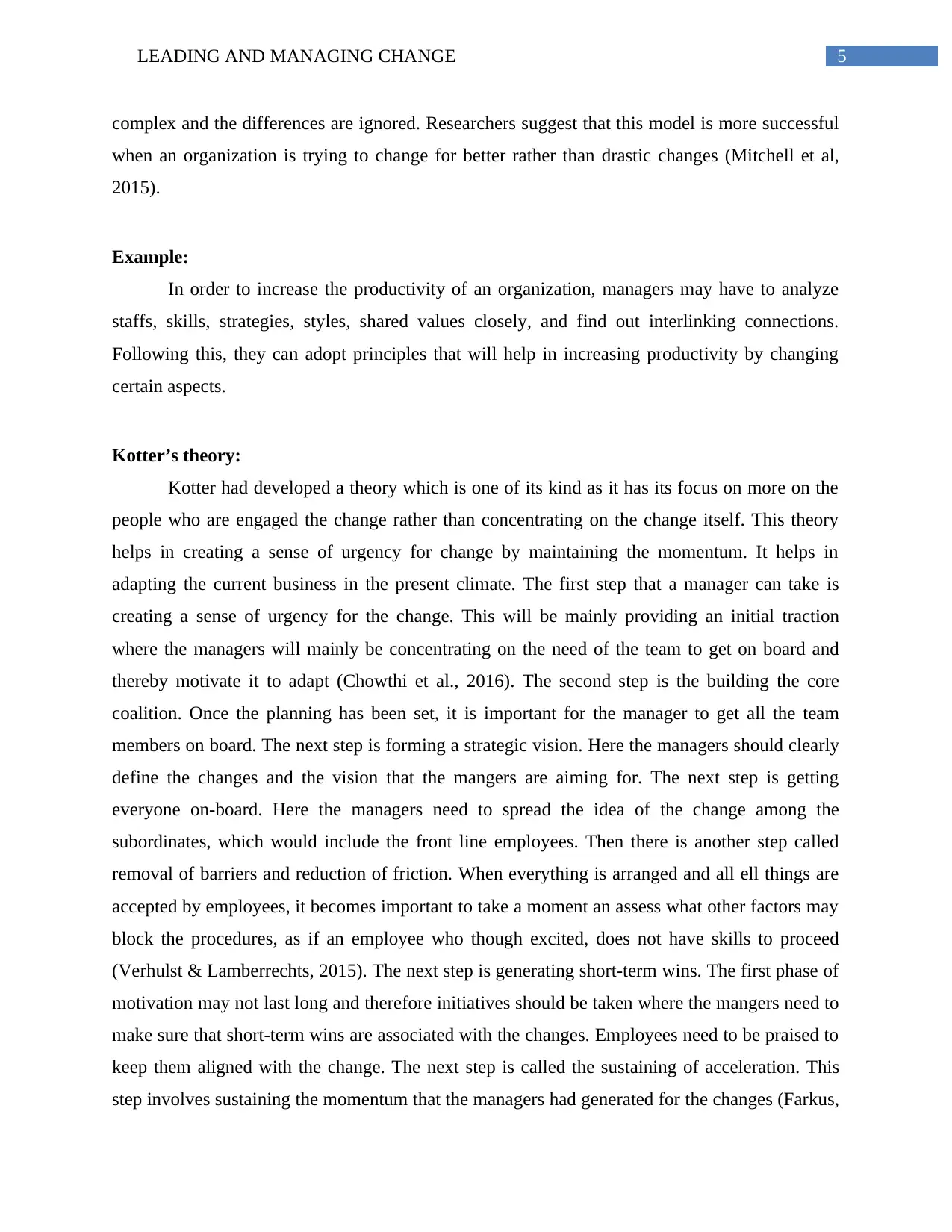
5LEADING AND MANAGING CHANGE
complex and the differences are ignored. Researchers suggest that this model is more successful
when an organization is trying to change for better rather than drastic changes (Mitchell et al,
2015).
Example:
In order to increase the productivity of an organization, managers may have to analyze
staffs, skills, strategies, styles, shared values closely, and find out interlinking connections.
Following this, they can adopt principles that will help in increasing productivity by changing
certain aspects.
Kotter’s theory:
Kotter had developed a theory which is one of its kind as it has its focus on more on the
people who are engaged the change rather than concentrating on the change itself. This theory
helps in creating a sense of urgency for change by maintaining the momentum. It helps in
adapting the current business in the present climate. The first step that a manager can take is
creating a sense of urgency for the change. This will be mainly providing an initial traction
where the managers will mainly be concentrating on the need of the team to get on board and
thereby motivate it to adapt (Chowthi et al., 2016). The second step is the building the core
coalition. Once the planning has been set, it is important for the manager to get all the team
members on board. The next step is forming a strategic vision. Here the managers should clearly
define the changes and the vision that the mangers are aiming for. The next step is getting
everyone on-board. Here the managers need to spread the idea of the change among the
subordinates, which would include the front line employees. Then there is another step called
removal of barriers and reduction of friction. When everything is arranged and all ell things are
accepted by employees, it becomes important to take a moment an assess what other factors may
block the procedures, as if an employee who though excited, does not have skills to proceed
(Verhulst & Lamberrechts, 2015). The next step is generating short-term wins. The first phase of
motivation may not last long and therefore initiatives should be taken where the mangers need to
make sure that short-term wins are associated with the changes. Employees need to be praised to
keep them aligned with the change. The next step is called the sustaining of acceleration. This
step involves sustaining the momentum that the managers had generated for the changes (Farkus,
complex and the differences are ignored. Researchers suggest that this model is more successful
when an organization is trying to change for better rather than drastic changes (Mitchell et al,
2015).
Example:
In order to increase the productivity of an organization, managers may have to analyze
staffs, skills, strategies, styles, shared values closely, and find out interlinking connections.
Following this, they can adopt principles that will help in increasing productivity by changing
certain aspects.
Kotter’s theory:
Kotter had developed a theory which is one of its kind as it has its focus on more on the
people who are engaged the change rather than concentrating on the change itself. This theory
helps in creating a sense of urgency for change by maintaining the momentum. It helps in
adapting the current business in the present climate. The first step that a manager can take is
creating a sense of urgency for the change. This will be mainly providing an initial traction
where the managers will mainly be concentrating on the need of the team to get on board and
thereby motivate it to adapt (Chowthi et al., 2016). The second step is the building the core
coalition. Once the planning has been set, it is important for the manager to get all the team
members on board. The next step is forming a strategic vision. Here the managers should clearly
define the changes and the vision that the mangers are aiming for. The next step is getting
everyone on-board. Here the managers need to spread the idea of the change among the
subordinates, which would include the front line employees. Then there is another step called
removal of barriers and reduction of friction. When everything is arranged and all ell things are
accepted by employees, it becomes important to take a moment an assess what other factors may
block the procedures, as if an employee who though excited, does not have skills to proceed
(Verhulst & Lamberrechts, 2015). The next step is generating short-term wins. The first phase of
motivation may not last long and therefore initiatives should be taken where the mangers need to
make sure that short-term wins are associated with the changes. Employees need to be praised to
keep them aligned with the change. The next step is called the sustaining of acceleration. This
step involves sustaining the momentum that the managers had generated for the changes (Farkus,
⊘ This is a preview!⊘
Do you want full access?
Subscribe today to unlock all pages.

Trusted by 1+ million students worldwide
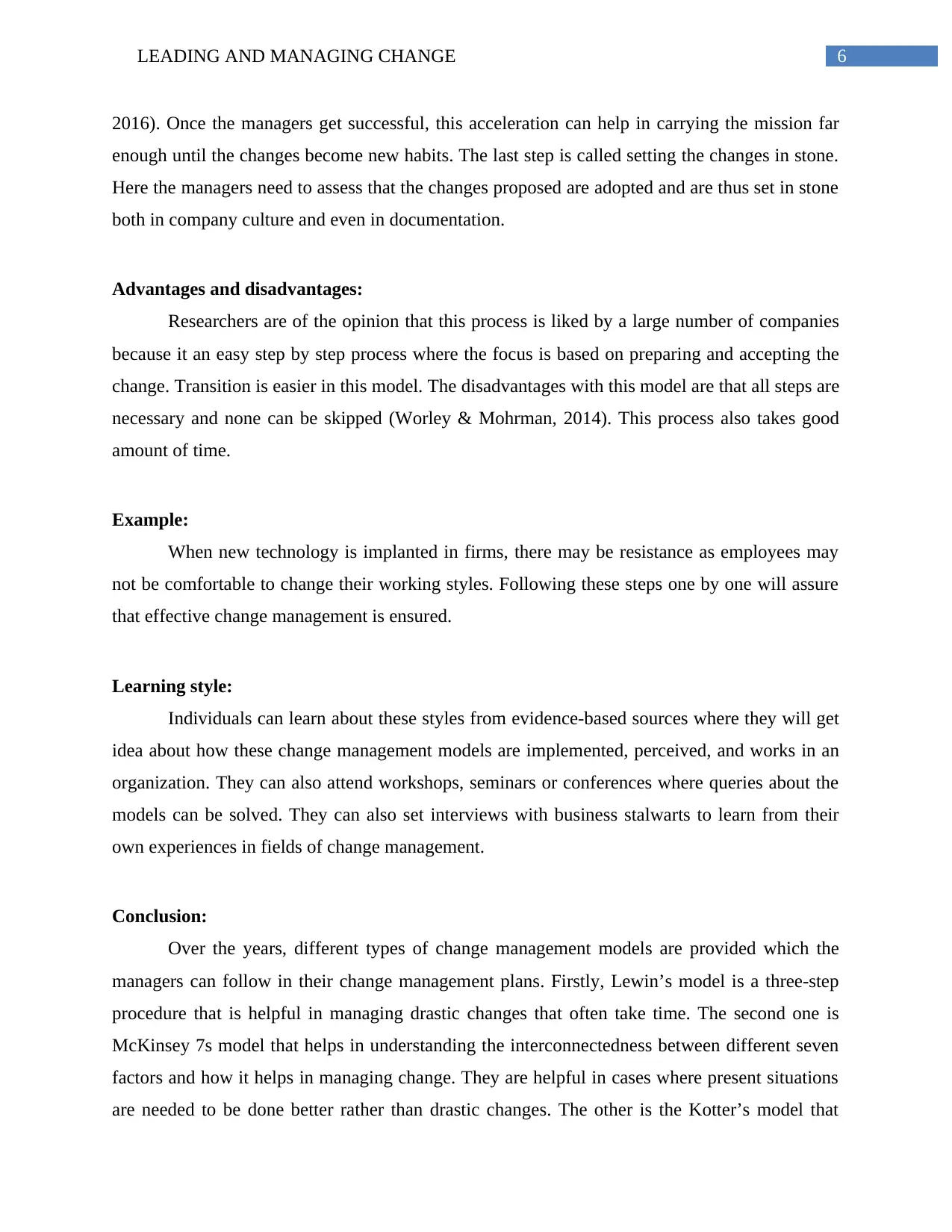
6LEADING AND MANAGING CHANGE
2016). Once the managers get successful, this acceleration can help in carrying the mission far
enough until the changes become new habits. The last step is called setting the changes in stone.
Here the managers need to assess that the changes proposed are adopted and are thus set in stone
both in company culture and even in documentation.
Advantages and disadvantages:
Researchers are of the opinion that this process is liked by a large number of companies
because it an easy step by step process where the focus is based on preparing and accepting the
change. Transition is easier in this model. The disadvantages with this model are that all steps are
necessary and none can be skipped (Worley & Mohrman, 2014). This process also takes good
amount of time.
Example:
When new technology is implanted in firms, there may be resistance as employees may
not be comfortable to change their working styles. Following these steps one by one will assure
that effective change management is ensured.
Learning style:
Individuals can learn about these styles from evidence-based sources where they will get
idea about how these change management models are implemented, perceived, and works in an
organization. They can also attend workshops, seminars or conferences where queries about the
models can be solved. They can also set interviews with business stalwarts to learn from their
own experiences in fields of change management.
Conclusion:
Over the years, different types of change management models are provided which the
managers can follow in their change management plans. Firstly, Lewin’s model is a three-step
procedure that is helpful in managing drastic changes that often take time. The second one is
McKinsey 7s model that helps in understanding the interconnectedness between different seven
factors and how it helps in managing change. They are helpful in cases where present situations
are needed to be done better rather than drastic changes. The other is the Kotter’s model that
2016). Once the managers get successful, this acceleration can help in carrying the mission far
enough until the changes become new habits. The last step is called setting the changes in stone.
Here the managers need to assess that the changes proposed are adopted and are thus set in stone
both in company culture and even in documentation.
Advantages and disadvantages:
Researchers are of the opinion that this process is liked by a large number of companies
because it an easy step by step process where the focus is based on preparing and accepting the
change. Transition is easier in this model. The disadvantages with this model are that all steps are
necessary and none can be skipped (Worley & Mohrman, 2014). This process also takes good
amount of time.
Example:
When new technology is implanted in firms, there may be resistance as employees may
not be comfortable to change their working styles. Following these steps one by one will assure
that effective change management is ensured.
Learning style:
Individuals can learn about these styles from evidence-based sources where they will get
idea about how these change management models are implemented, perceived, and works in an
organization. They can also attend workshops, seminars or conferences where queries about the
models can be solved. They can also set interviews with business stalwarts to learn from their
own experiences in fields of change management.
Conclusion:
Over the years, different types of change management models are provided which the
managers can follow in their change management plans. Firstly, Lewin’s model is a three-step
procedure that is helpful in managing drastic changes that often take time. The second one is
McKinsey 7s model that helps in understanding the interconnectedness between different seven
factors and how it helps in managing change. They are helpful in cases where present situations
are needed to be done better rather than drastic changes. The other is the Kotter’s model that
Paraphrase This Document
Need a fresh take? Get an instant paraphrase of this document with our AI Paraphraser
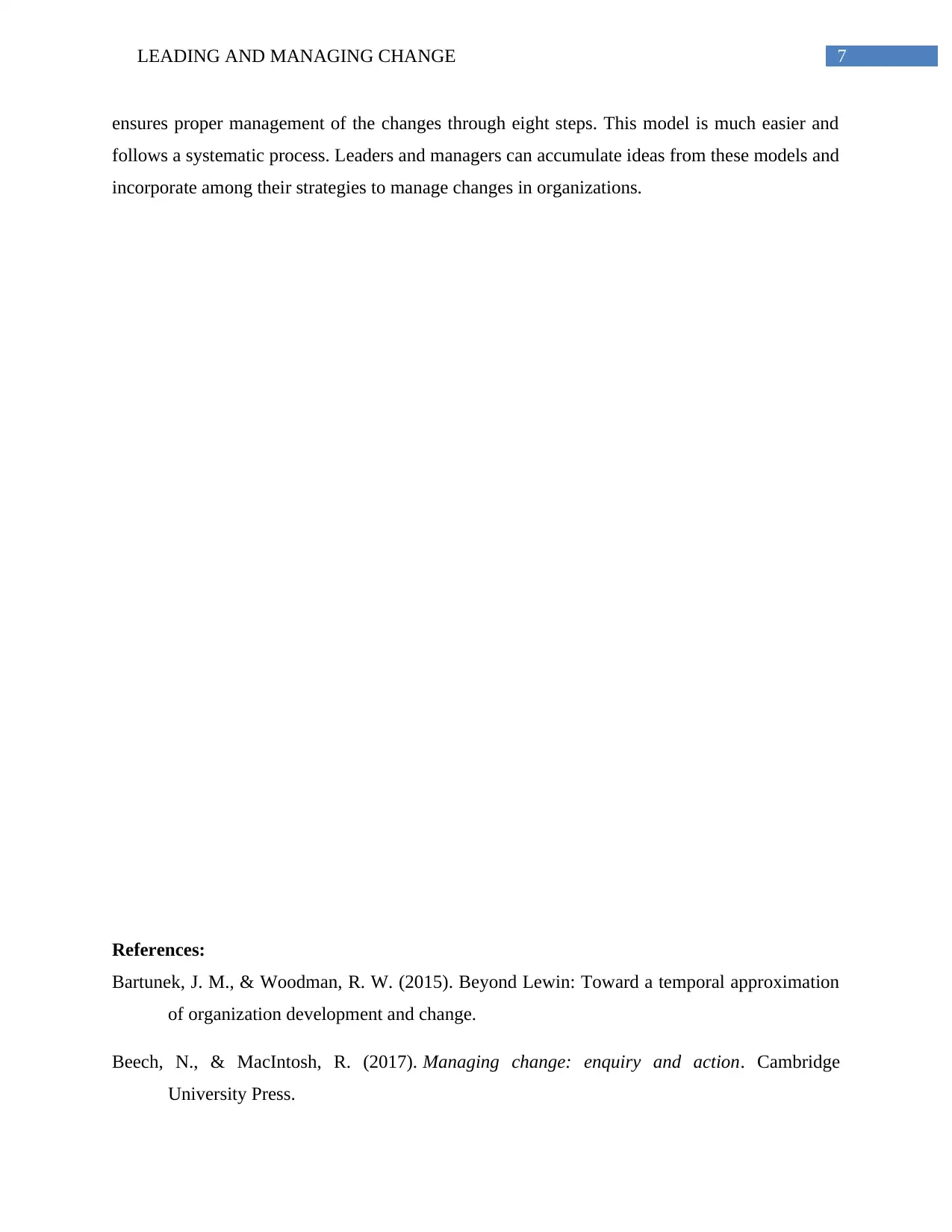
7LEADING AND MANAGING CHANGE
ensures proper management of the changes through eight steps. This model is much easier and
follows a systematic process. Leaders and managers can accumulate ideas from these models and
incorporate among their strategies to manage changes in organizations.
References:
Bartunek, J. M., & Woodman, R. W. (2015). Beyond Lewin: Toward a temporal approximation
of organization development and change.
Beech, N., & MacIntosh, R. (2017). Managing change: enquiry and action. Cambridge
University Press.
ensures proper management of the changes through eight steps. This model is much easier and
follows a systematic process. Leaders and managers can accumulate ideas from these models and
incorporate among their strategies to manage changes in organizations.
References:
Bartunek, J. M., & Woodman, R. W. (2015). Beyond Lewin: Toward a temporal approximation
of organization development and change.
Beech, N., & MacIntosh, R. (2017). Managing change: enquiry and action. Cambridge
University Press.
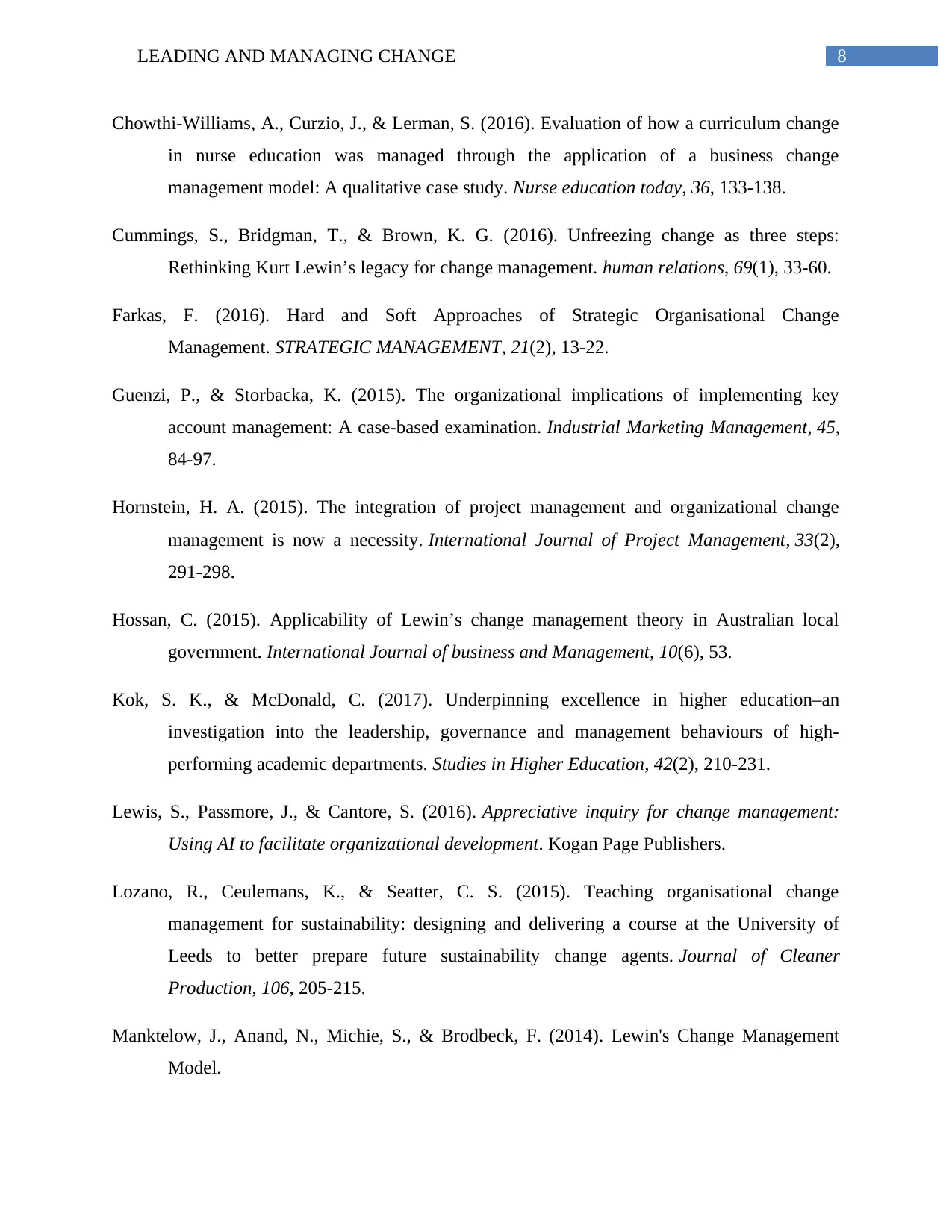
8LEADING AND MANAGING CHANGE
Chowthi-Williams, A., Curzio, J., & Lerman, S. (2016). Evaluation of how a curriculum change
in nurse education was managed through the application of a business change
management model: A qualitative case study. Nurse education today, 36, 133-138.
Cummings, S., Bridgman, T., & Brown, K. G. (2016). Unfreezing change as three steps:
Rethinking Kurt Lewin’s legacy for change management. human relations, 69(1), 33-60.
Farkas, F. (2016). Hard and Soft Approaches of Strategic Organisational Change
Management. STRATEGIC MANAGEMENT, 21(2), 13-22.
Guenzi, P., & Storbacka, K. (2015). The organizational implications of implementing key
account management: A case-based examination. Industrial Marketing Management, 45,
84-97.
Hornstein, H. A. (2015). The integration of project management and organizational change
management is now a necessity. International Journal of Project Management, 33(2),
291-298.
Hossan, C. (2015). Applicability of Lewin’s change management theory in Australian local
government. International Journal of business and Management, 10(6), 53.
Kok, S. K., & McDonald, C. (2017). Underpinning excellence in higher education–an
investigation into the leadership, governance and management behaviours of high-
performing academic departments. Studies in Higher Education, 42(2), 210-231.
Lewis, S., Passmore, J., & Cantore, S. (2016). Appreciative inquiry for change management:
Using AI to facilitate organizational development. Kogan Page Publishers.
Lozano, R., Ceulemans, K., & Seatter, C. S. (2015). Teaching organisational change
management for sustainability: designing and delivering a course at the University of
Leeds to better prepare future sustainability change agents. Journal of Cleaner
Production, 106, 205-215.
Manktelow, J., Anand, N., Michie, S., & Brodbeck, F. (2014). Lewin's Change Management
Model.
Chowthi-Williams, A., Curzio, J., & Lerman, S. (2016). Evaluation of how a curriculum change
in nurse education was managed through the application of a business change
management model: A qualitative case study. Nurse education today, 36, 133-138.
Cummings, S., Bridgman, T., & Brown, K. G. (2016). Unfreezing change as three steps:
Rethinking Kurt Lewin’s legacy for change management. human relations, 69(1), 33-60.
Farkas, F. (2016). Hard and Soft Approaches of Strategic Organisational Change
Management. STRATEGIC MANAGEMENT, 21(2), 13-22.
Guenzi, P., & Storbacka, K. (2015). The organizational implications of implementing key
account management: A case-based examination. Industrial Marketing Management, 45,
84-97.
Hornstein, H. A. (2015). The integration of project management and organizational change
management is now a necessity. International Journal of Project Management, 33(2),
291-298.
Hossan, C. (2015). Applicability of Lewin’s change management theory in Australian local
government. International Journal of business and Management, 10(6), 53.
Kok, S. K., & McDonald, C. (2017). Underpinning excellence in higher education–an
investigation into the leadership, governance and management behaviours of high-
performing academic departments. Studies in Higher Education, 42(2), 210-231.
Lewis, S., Passmore, J., & Cantore, S. (2016). Appreciative inquiry for change management:
Using AI to facilitate organizational development. Kogan Page Publishers.
Lozano, R., Ceulemans, K., & Seatter, C. S. (2015). Teaching organisational change
management for sustainability: designing and delivering a course at the University of
Leeds to better prepare future sustainability change agents. Journal of Cleaner
Production, 106, 205-215.
Manktelow, J., Anand, N., Michie, S., & Brodbeck, F. (2014). Lewin's Change Management
Model.
⊘ This is a preview!⊘
Do you want full access?
Subscribe today to unlock all pages.

Trusted by 1+ million students worldwide
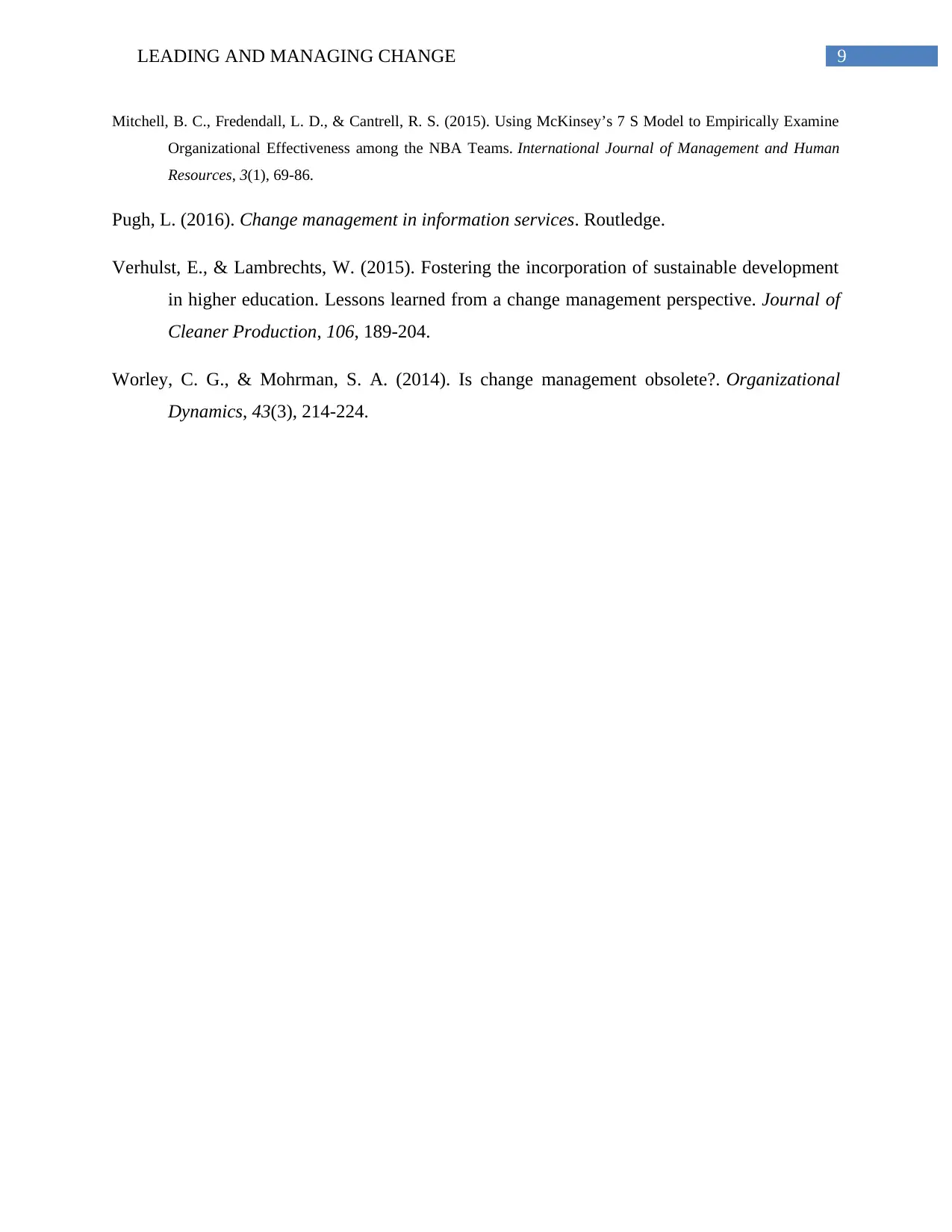
9LEADING AND MANAGING CHANGE
Mitchell, B. C., Fredendall, L. D., & Cantrell, R. S. (2015). Using McKinsey’s 7 S Model to Empirically Examine
Organizational Effectiveness among the NBA Teams. International Journal of Management and Human
Resources, 3(1), 69-86.
Pugh, L. (2016). Change management in information services. Routledge.
Verhulst, E., & Lambrechts, W. (2015). Fostering the incorporation of sustainable development
in higher education. Lessons learned from a change management perspective. Journal of
Cleaner Production, 106, 189-204.
Worley, C. G., & Mohrman, S. A. (2014). Is change management obsolete?. Organizational
Dynamics, 43(3), 214-224.
Mitchell, B. C., Fredendall, L. D., & Cantrell, R. S. (2015). Using McKinsey’s 7 S Model to Empirically Examine
Organizational Effectiveness among the NBA Teams. International Journal of Management and Human
Resources, 3(1), 69-86.
Pugh, L. (2016). Change management in information services. Routledge.
Verhulst, E., & Lambrechts, W. (2015). Fostering the incorporation of sustainable development
in higher education. Lessons learned from a change management perspective. Journal of
Cleaner Production, 106, 189-204.
Worley, C. G., & Mohrman, S. A. (2014). Is change management obsolete?. Organizational
Dynamics, 43(3), 214-224.
1 out of 10
Related Documents
Your All-in-One AI-Powered Toolkit for Academic Success.
+13062052269
info@desklib.com
Available 24*7 on WhatsApp / Email
![[object Object]](/_next/static/media/star-bottom.7253800d.svg)
Unlock your academic potential
Copyright © 2020–2025 A2Z Services. All Rights Reserved. Developed and managed by ZUCOL.




